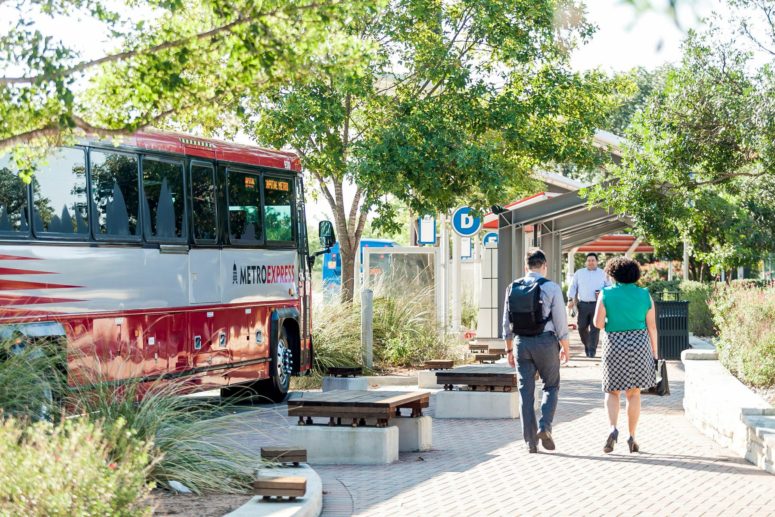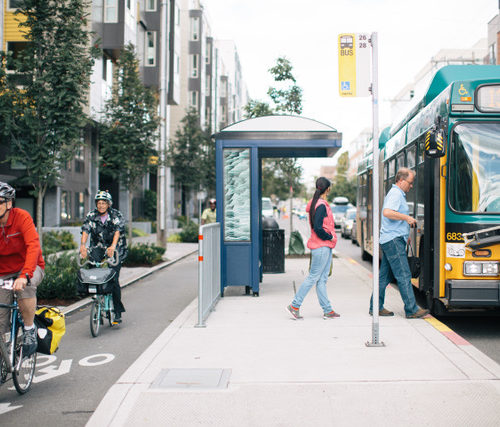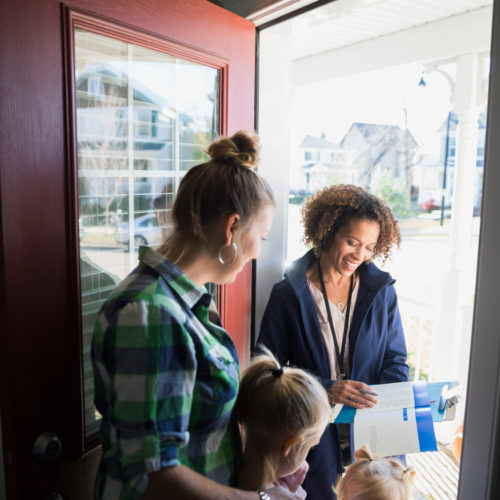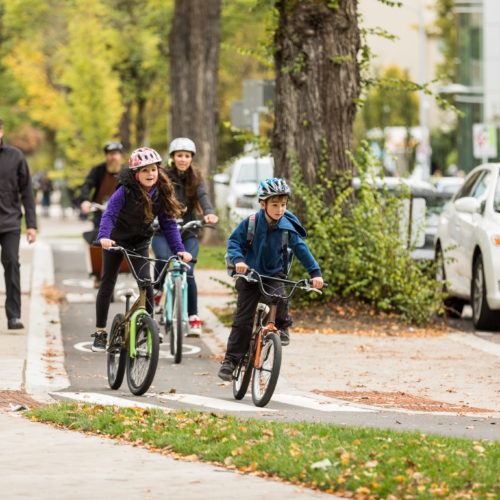City Thread’s work in Austin and Providence offers two case studies on how to best practice inclusive communication and reach non-traditional audiences.
At City Thread, we believe we can all have peace on the road — and more livable communities — when we all have a piece of the road.
Getting there, however, is the harder part. While the principles of a good communication strategy will work in most markets, every city is different and a tailored approach is necessary to ensure lasting success.
“All of our campaigns are different, although the same framework generally works from place to place,” says City Thread Partner Kyle Wagenschutz. “It’s all centered around real data as the backbone of the strategy.”
In 2022, the City Thread team wrapped up its Final Mile project, a program aimed at transforming five cities into great places to bike in record time. In each of the five markets, polling and surveying data were conducted and a unique strategy was formed based on the current opinions of the public. After defining the audience and their top areas of concern, we were able to customize messaging to suit those objectives. In some markets, digital ads made more sense than others, as did specific messaging about safer streets for kids or less congested roads for drivers.
Two cities, Austin, Texas, and Providence, Rhode Island, stand out thanks to the different communications tactics employed and the success each experienced when it comes to mobility network acceleration.
Austin, Texas
The City of Austin set an ambitious goal: Build a 400-mile bicycle network that winds throughout the city, connecting urban trails, quiet neighborhood streets, and new protected bike lanes. Create a network that would offer residents a choice in how they get around, no matter the person’s age or ability. The network would be accompanied by significant street crossing improvements and other infrastructure updates, eventually delivering more mobility options, relief from congestion, greater safety to all, and a more livable community for Austin residents.
To help bring this vision to fruition, the City Thread team worked closely with government planners and Jim Wick, the lead organizer for MoveATX, an advocacy organization dedicated to helping create a new mobility future. All players understood that to create the network, the passage of two voter-approved mobility bonds was necessary. Getting people on board with the bonds and the network necessitated large-scale, targeted messaging.
Wick relied heavily on polling to first understand the landscape and environment he was working in. “You have to understand how people feel about these issues before you ask them for money or approve the installation of projects,” he says. “That’s key.”
Another key messaging lesson? Don’t talk about bikes.
Instead, frame the conversation around mobility networks, moving people around, and safety. Something that resonated in Austin was the idea of freedom and designing streets so that every user has their own space where they can use their preferred means of mobility, whether that’s walking, scooting, using a wheelchair, or driving.
“Our messaging was aimed at car users — people who drive cars, like me, for most of their mobility trips,” says Wick. “Our research indicated that there’s a large group of people whose primary means of transportation is an automobile who would either be interested in taking a trip using different means or would be interested in infrastructure that creates those types of places where there’s a separation of modes.”
Thanks to comprehensive political-style polling of a sample that represented the electorate (since the mobility bonds required votes), it became clear that about 60% of people were interested in a new mobility network, while 40% of people would never do anything but drive. It was determined that some were reachable through messaging and some weren’t — Wick believes that distinction is key to making informed communications decisions. The team also conducted around 500 cell phone surveys, asking people about their mobility attitudes, before embarking on a major media campaign.
Wick helped to create messaging aimed at car users, focusing on how a mobility network can help ease congestion and promote safety benefits.
In Texas — and in most cities throughout the U.S. — people drive SUVs or big trucks, and they don’t want to compete with people on bikes or scooters in the roadway. A dedicated mobility network can appeal to this subset because it means they don’t have to share the road. Messaging also aimed to normalize infrastructure, with ads that showcased what a safe, connected mobility network looked like, so when one went in their neighborhood, it wouldn’t be a shock.
Ultimately, Austin was successful in passing both of its transportation bonds, helping the city build more than 50% of its anticipated AAA network and set a 100% completion goal for 2025. For Wick, success is less tied to door knocking, mailers, and television ads than figuring out what it is people want and putting forward a plan that appeals to them. In many cases, a high-quality survey can trump a typical public engagement process where the same anti-growth residents always show up.
It’s about shifting away from the old way of thinking — i.e. “How do we persuade people to get out of their cars?” — and towards a newer way, where we set out a vision for them to do it. In Austin, polling showed that a majority of people had an inherent desire for the new mobility network. To get something passed, a majority is all you need and focused messaging on that group ended up being a winning strategy. Wick believes that the larger behavioral change will happen naturally as a result of the transportation bonds passing.
“Know your landscape, then forget the conventional strategy,” says Wick. “If you want to see radical change, you need a radical strategy.”
Providence, Rhode Island
At the outset of the Final Mile in 2017, Liza Burkin was brought on as the lead organizer at the Providence Streets Coalition, a brand new advocacy organization that she was tasked with building up from scratch. After undergoing training with the City Thread team, one piece of messaging stood out and has informed her communications strategy since: Remove the words “bikes” or “bicycling” from everything you do.
In the beginning, aside from starting all the essential communication channels (social media, newsletters, a website), Burkin actually invested almost a year focusing on transit. That helped her build trust with a crucial demographic that later showed up in support of mobility networks. In 2021, when things in the city came together and it was time to start building support for implementing that network, the Providence Streets Coalition already had two polls under its belt.
“We shared those polls wherever we could — in public meetings, with city government officials, with the mayor’s team, with the media,” says Burkin. “They also ultimately helped us inform our yard sign program.”
Polling in Providence spoke to people’s desire for safer streets and the Providence Streets Coalition yard signs fed into that with slogans like, “We Vote For Safer Streets” and “We Support Safer Streets.”
Polling also showed that the term urban trails appealed to people more than bike lanes and that more people were interested in bicycling as a form of recreation than transportation. Helping people see that recreation could also be transportation proved crucial to getting people on board with urban trails.
In all touchpoints with residents, whether that was through door knocking, on-street tabling, or a mass texting campaign, Burkin and other volunteers emphasized the universal benefits and top-of-mind issues for city residents. For example, asthma and air pollution, and specifically how they affect children, are all important issues in Providence, especially for BIPOC communities. Helping folks make the connection between climate and mobility networks proved to be crucial when it came to garnering support.
“So much of our work was also about building trust,” says Burkin, noting that the Providence Streets Coalition primarily did that through partnerships with community-based organizations that had no connection to bicycling. “Because it’s a partnership, that means you also have to show up for them.”
Burkin also considers government officials and politicians to be ripe for partnership, alongside reporters and others with influence. Cultivating relationships and helping people write op-eds ensured that the Providence Streets Coalition messaging was always reaching new audiences.
Likewise, to reach Providence’s large population of Spanish speakers, every campaign was completely bilingual.
The Providence Streets Coalition’s early emphasis on transit played well with Spanish speakers and other communities of color. It also helped that almost all of Providence’s mobility projects included reconstructed curb ramps, new crosswalks, and bus islands in addition to two-way, protected urban trails. Burkin also believes that taking a complete streets approach and emphasizing overall community health benefits allowed advocates to counteract worries about bike lanes causing gentrification.
“The new designs made it safer for all sorts of users to move, so they could really see the benefit,” says Burkin, adding that another campaign also helped people envision who the mobility projects would serve and how they fit into the community. “We hired a local portrait photographer to take high-quality photographs of about 40 individuals, who we asked the same set of questions about their individual stories of mobility and safety. That type of storytelling was huge.”
Let’s talk about the opportunities in your community and how we can work together. Reach out at info@citythread.org.





